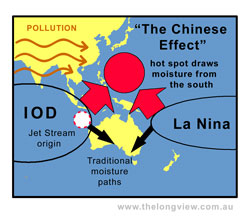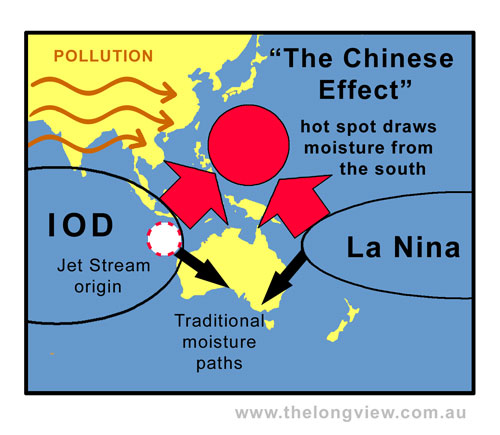|
The
Chinese Effect
In 2006, Kevin Long was the first
to name and identify the impacts of
"The Chinese Effect" on Australia's weather.
Kevin believes this to be the major tipping force behind climate change
for south-eastern Australia.
See documents
& links below.
|

SEE
LARGE IMAGE BELOW
|
"The
Chinese Effect"
is the annual warming of the seas north of New Guinea due
to Asian aerosol pollution.
The hotspot draws moisture in from south of
the equator, thus reducing the moisture available to the Australian
rainfall systems. The hotspot has been very apparent since 2004.
This significant and increasing effect on Australian weather has not
been recognised by governments and water management authorities.
We are not dealing with a conventional "drought" that is going to
"break". We are witnessing distinct "climate change" due to a
new pattern of equatorial moisture flows.
Kevin has published
two documents specifically on
"The Chinese Effect" :
| 2009
|
The
Chinese Effect Part 2:
Its
impacts on the Indian Ocean Dipole
Includes:
updated hypothesis, supporting
scientific
study on the weakening rain effects of the IOD, the recent UN
identification of effects of "Atmospheric Brown Clouds", the
possible slowing of the "Great Oean Conveyor Belt", demnstrated effects
on Central Victoria's rainfall and moisture patterns.
|
2
pages |
| 2006 |
The
Chinese Effect
Original
summary document
outlining hypothesis of the pollution cloud drawing moisture away from
the La Nina rainfall system affecting south-eatern Australia.
|
1
page |
There has been a recent growing international awareness of the climate
effects of major pollution clouds (e.g. 2008 UN report on Asian
"Atmospheric Brown Clouds").
However there has been little or no scientific investigation regarding
the direct observational link between the increasing warming of the
seas north of New Guinea and the decline in rainfall in south-eastern
Australia.
Kevin sums up the situation:
"As
long as there is more pollution being produced in the Northern
Hemisphere than in the Southern Hemisphere, then south-eastern
Australia’s rainfall will continue to be drawn northward."

"THE CHINESE EFFECT" LINKS
Maps and images illustrating the Chinese Effect
Research
Sources quoted in "The Chinese Effect - Part 2"
Ummenhofer
et al 2009
“What
causes southeast Australia’s worst
droughts?”
Geophysical Research Letters, Vol. 36 |
Australian
academic research paper which was widely reported in the Australian
media in early 2009. It discusses the role of the Indian Ocean Dipole
as a driver of rainfall in south-eastern Australia, and its weakened
effect since 1992. |
United Nations Environment Program
2008
“Atmospheric
Brown Clouds: Regional Assessment Report with Focus on Asia” |
United
Nations report on Asian aerosol
pollution and its effects on health, agriculture, climate and economy. |
More information and
links will be added to this page over time.
Sign
up here
for "The Long View" email list.
|
|

BACK TO
HOME
PAGE
Kevin Long
invites further investigation of "The Chinese Effect".
Please
contact him
for discussion.
|
|
|
|
|
|
 MORE INFO
MORE INFO
From
$200
per year.
For your particular
area of Australia ...
A detailed regular forecast service with ongoing updates,
suitable for agricultural producers.
Talk to Kevin
about your needs.
CONTACT KEVIN
|











